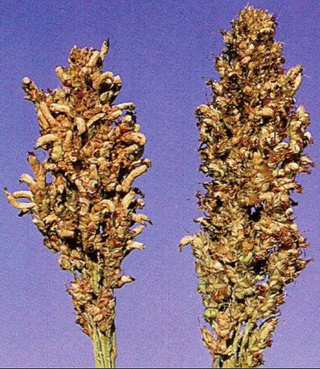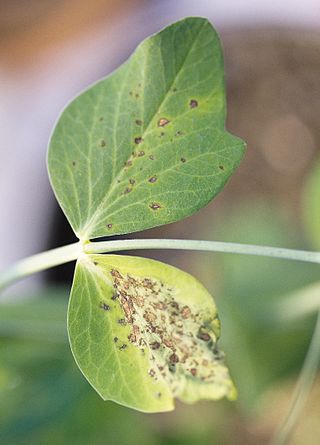
The fungal genus Cochliobolus includes 19 species, it includes some plant pathogenic species such as Cochliobolus heterostrophus. A lot of former Cochliobolus species were transferred to either Curvularia or Bipolaris genera.

Armillaria luteobubalina, commonly known as the Australian honey fungus, is a species of mushroom in the family Physalacriaceae. Widely distributed in southern Australia, the fungus is responsible for a disease known as Armillaria root rot, a primary cause of Eucalyptus tree death and forest dieback. It is the most pathogenic and widespread of the six Armillaria species found in Australia. The fungus has also been collected in Argentina and Chile. Fruit bodies have cream- to tan-coloured caps that grow up to 10 cm (4 in) in diameter and stems that measure up to 20 cm (8 in) long by 1.5 cm (1 in) thick. The fruit bodies, which appear at the base of infected trees and other woody plants in autumn (March–April), are edible, but require cooking to remove the bitter taste. The fungus is dispersed through spores produced on gills on the underside of the caps, and also by growing vegetatively through the root systems of host trees. The ability of the fungus to spread vegetatively is facilitated by an aerating system that allows it to efficiently diffuse oxygen through rhizomorphs—rootlike structures made of dense masses of hyphae.
Drechslera wirreganensis is a plant pathogen causing Platyspora Leaf Spot.

Claviceps sorghi is a fungal plant pathogen belonging to the phylum Ascomycota in the kingdom Fungi- its anamorphic phase is known as sphacelia sorghi. This species was first found in In India in 1915 and officially recorded in 1948 . The Claviceps genus is known for their infection of cereal and millet crops. This particular species of Claviceps infects Sorghum- giving the fungus its name 'sorghi'. These species in Claviceps are known to produce ergot on their host, as a byproduct of their infection. This can cause the disease known as ergotism when the infected crop is consumed.

Didymella pinodes is a hemibiotrophic fungal plant pathogen and the causal agent of ascochyta blight on pea plants. It is infective on several species such as Lathyrus sativus, Lupinus albus, Medicago spp., Trifolium spp., Vicia sativa, and Vicia articulata, and is thus defined as broadrange pathogen.

Cochliobolus carbonum is one of more than 40 species of filamentous ascomycetes belonging to the genus Cochliobolus. This pathogen has a worldwide distribution, with reports from Australia, Brazil, Cambodia, Canada, China, Congo, Denmark, Egypt, India, Kenya, New Zealand, Nigeria, Solomon Islands, and the United States. Cochliobolus carbonum is one of the most aggressive members of this genus infecting sorghum, corn and apple. As one of the most devastating pathogens of sweet corn, C. carbonum causes Northern leaf spot and ear rot disease while the asexual stage causes Helminthosporium corn leaf spot. Cochliobolus carbonum is pathogenic to all organs of the corn plant including root, stalk, ear, kernel, and sheath. However, symptoms of infection show distinct manifestations in different plant parts: whole plant - seedling blight affects the whole plant, leaf discoloration and mycelial growth, black fungal spores and lesions appear on inflorescences and glumes, and grain covered with very dark brown to black mycelium which gives a characteristic charcoal appearance due to the production of conidia.

Setosphaeria rostrata is a heat tolerant fungus with an asexual reproductive form (anamorph) known as Exserohilum rostratum. This fungus is a common plant pathogen, causing leaf spots as well as crown rot and root rot in grasses. It is also found in soils and on textiles in subtropical and tropical regions. Exserohilum rostratum is one of the 35 Exserohilum species implicated uncommonly as opportunistic pathogens of humans where it is an etiologic agent of sinusitis, keratitis, skin lesions and an often fatal meningoencephalitis. Infections caused by this species are most often seen in regions with hot climates like Israel, India and the southern USA.
Camillea tinctor is a species of fungus in the family Graphostromataceae. It is a plant pathogen and saprophyte of dying or weakened trees such as sycamore, oak, or elm. The fungus causes cankers on large branches or the tree trunk. Ascospores of this fungus are transported by wind or rain that can infect existing wounds in trees. It can be identified by orange staining that can be seen on cut wood, and it has protruding ostioles.

Bipolaris is a genus of fungi belonging to the family Pleosporaceae. It was circumscribed by mycologist Robert A. Shoemaker in 1959.
Maculatifrondes is a genus of fungi in the order Phyllachorales. This is a monotypic genus, containing the single species Maculatifrondes aequatoriensis. The fungus, first discovered in Ecuador, is associated with leaf spot of palms.
Phaeohyphomycosis is a diverse group of fungal infections, caused by dematiaceous fungi whose morphologic characteristics in tissue include hyphae, yeast-like cells, or a combination of these. It can be associated an array of melanistic filamentous fungi including Alternaria species,Exophiala jeanselmei, and Rhinocladiella mackenziei.
A species of the genus of Penicillium which causes Blue Mold of Garlic on Allium sativum L. The genus name is derived from the Latin root penicillum, meaning "painter's brush", and refers to the chains of conidia this fungus produces that resemble a broom.
Exserohilum curvatum is a species of fungus in the family Pleosporaceae. Found in Venezuela, where it grows on the leaves of Sorghum, it was described as new to science in 1984. It differs from other Exserohilum species by its distinctly curved conidia.
Exserohilum inaequale is a species of fungus in the family Pleosporaceae. Found in Nigeria, it was described as new to science in 1984. It differs from other Exserohilum species in the size, shape, and septation of its conidia. Additionally, the septa are comparatively dark and thick.
Exserohilum oryzicola is a species of fungus in the family Pleosporaceae. Found in Colombia, where it grows on the leaves of Oryza sativa, it was described as new to science in 1984. It is distinguished from other Exserohilum species by its longer and more tapered conidia.
Exserohilum longirostratum is a species of fungus in the family Pleosporaceae. Found in India, it was described as new to science in 1957 as Helminthosporium longirostratum, and transferred to the genus Exserohilum in 1984.
Phaeocollybia pseudolugubris is a species of fungus in the family Cortinariaceae. Found in the Popocatépetl region of México State, where it grows in forests of sacred fir and pine, it was described as new to science in 1996 by mycologists Victor Bandala and Egon Horak. It is a member of section Versicolores in the genus Phaeocollybia. Its spores are more or less ellipsoidal to almond-shaped, typically measuring 8–9 by 4–5 µm. Clamp connections are absent from the hyphae.

Cladosporium sphaerospermum is a radiotrophic fungus belonging to the genus Cladosporium and was described in 1886 by Albert Julius Otto Penzig from the decaying leaves and branches of Citrus. It is a dematiaceous (darkly-pigmented) fungus characterized by slow growth and largely asexual reproduction. Cladosporium sphaerospermum consists of a complex of poorly morphologically differentiated, "cryptic" species that share many physiological and ecological attributes. In older literature, all of these sibling species were classified as C. sphaerospermum despite their unique nature. Accordingly, there is confusion in older literature reports on the physiological and habitat regularities of C. sphaerospermum in the strict sense. This fungus is most phylogenetically similar to C. fusiforme. According to modern phylogenetic analyses, the previously synonymized species, Cladosporium langeroni, is a distinct species.
Curvularia pallescens is a soil fungus, that commonly grows on crops found in tropical regions. The conidia of the fungus are distinguishable from those of related species due to their lack of curvature. C. pallescens has been reported to cause infection in plants, and in immunocompetent individuals. This species is the anamorph of Cochliobolus pallescens.
Curvularia inaequalis is a plant saprobe that resides in temperate and subtropical environments. It is commonly found in the soils of forage grasses and grains. The species has been observed in a broad distribution of countries including Turkey, France, Canada, The United States, Japan and India. This species is dematiaceous and a hyphomycete.








